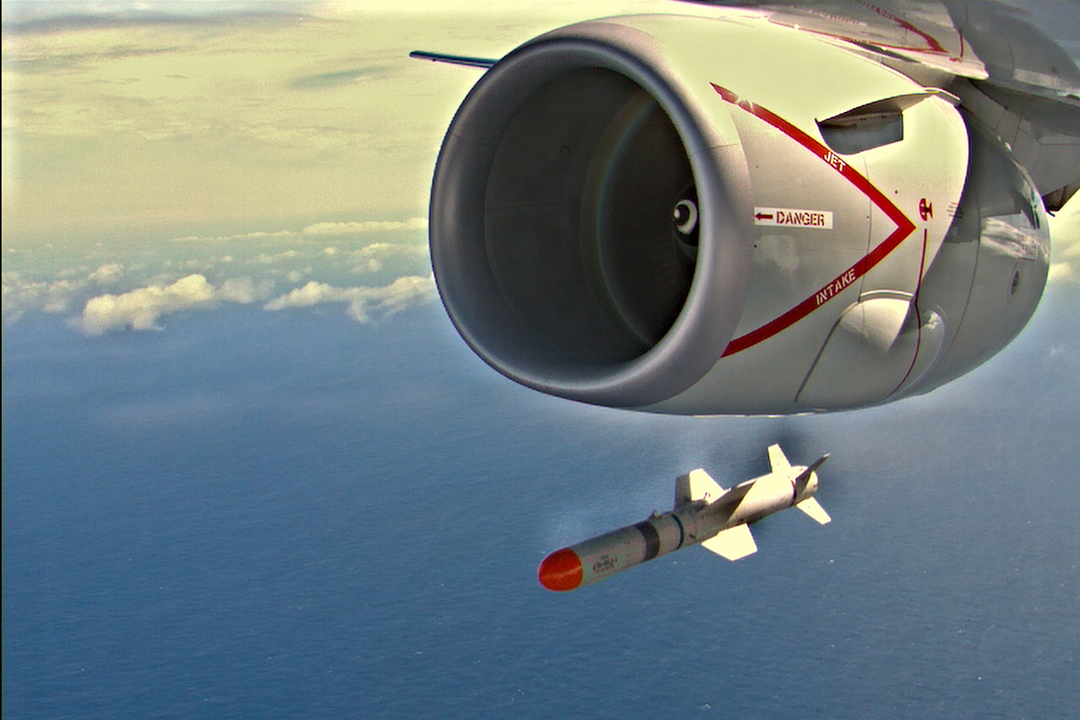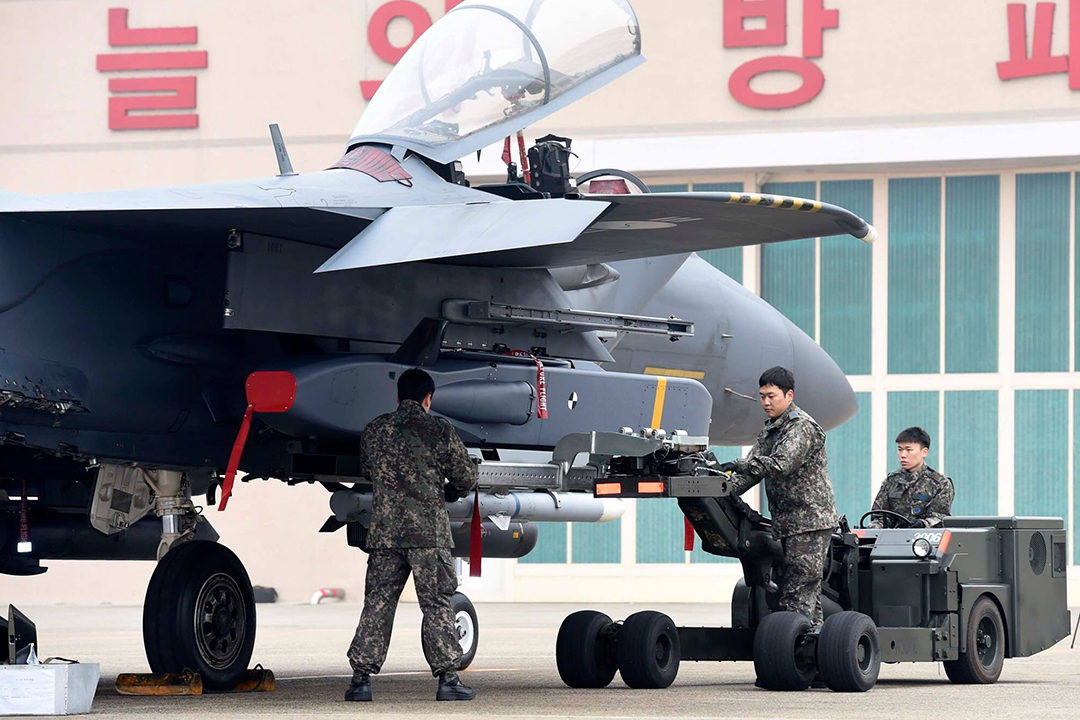
Published in the November/December 2020 Issue – Increasing the range of air-to-surface missiles has become an important factor in penetrating A2/AD defences, particularly in the maritime environment.
In the early years of air power, aircraft had to overfly their targets in order to deliver a meaningful effect, thereby exposing themselves to anti-aircraft defences. Even strafing (striking a ground target with gun or cannon fire) usually required the attacking aircraft to fly within the envelope of defensive weapons and systems. More recently, unguided rockets allowed an attacking aircraft to stand off a little further, but with a loss of accuracy and precision such that Royal Air Force (RAF) pilots in the 1980s viewed the unguided rockets such as the Societe Nouvelle des Etablissements Edgar Brandt (SNEB) 2.7 inch (68mm) as an ‘area’ weapon and not as a precise direct fire weapon like a gun.
Guided missiles offer greater stand-off range and precision. But because missiles represent a difficult target, it is always preferable to engage the missile launch platform before it has reached its firing point. This has led to the development of longer-range defensive systems which have, in turn, required the production of longer-ranged, faster, lower-flying, and lower signature missiles.
The employment of long-range air launched missiles in much of the Indo-Pacific region is further complicated by China’s growing anti-access/area denial (A2/AD) capabilities, which aim to push enemy missile launch platforms further out from Chinese targets, preventing them from operating close enough to China’s coast to be able to pose a threat.
The anti-access element of China’s A2/AD strategy uses attack aircraft, warships, and submarines, as well as precision-guided ballistic missiles and advanced land-attack cruise missiles to create a heavily contested air and surface environment over a very wide area.
Area denial (the denial of an enemy’s freedom of action in areas under friendly control) relies on the use of defensive systems including anti-aircraft fire (AAA), surface-to-air missiles (SAMs), fighter aircraft, and other air defence systems. In recent years anti-satellite weapons have been added to the mix, giving an ability to disrupt the satellite communications and GPS capabilities on which attacking aircraft, ships and other forces rely.
China’s A2/AD bubble
China’s occupation and militarisation of islands and reefs in the South China Sea – especially in the Spratly Islands (which China calls the Nansha islands) and the Paracel (Xisha) islands has extended China’s A2/AD bubble so that it stretches beyond the so-called first island chain that stretches from the Kamchatka Peninsula to the Malay Peninsula, encompassing the Kuril Islands, Japanese Archipelago, Ryukyu Islands, Taiwan (Formosa), the northern Philippines, and Borneo, and which already includes most of the Yellow Sea, the South China Sea and the East China Sea.
By building advanced airbases that could accommodate tactical aircraft, bombers and missiles on Fiery Cross Reef, Subi Reef and Mischief Reef (all of which lie within the Philippines’ 200 nautical mile Exclusive Economic Zone), China has effectively reneged on Xi Jinping’s September 2015 assurance that it did not intend to pursue militarisation of the Spratly islands, and has affectively brought the second island chain within China’s A2/AD bubble (including the Mariana Islands, with the United States territory of Guam).
A2/AD does not create an impenetrable zone, nor some kind of ‘no go area’, but it does turn what would have been a permissive operating environment into one that is contested. It does not necessarily prevent enemy forces from operating within a particular area of operations, but it does place them at risk if they do so, and it does severely constrain their freedom of movement and freedom of navigation when doing so. It places even greater emphasis on stand-off weaponry, because long range missiles minimises the launch platform’s exposure to enemy defences.
Due to the Missile Technology Control Regime (MTCR) multilateral export control regulations, relatively few Asian air forces have a significant stand-off overland attack capability. Though MTCR was intended to limit the spread of of weapons of mass destruction (WMD), it does so by reducing the proliferation of missiles and missile technology, and specifically targets weapons capable of delivering payloads of 500 -1,100lb (500kg) or more over ranges greater than 190 miles (300km).
Apart from China, Australia and South Korea are the main Asian operators of long-range air-to-surface missiles. The Australian government selected the Lockheed Martin AGM-158 Joint Air-to-Surface Standoff Missile (JASSM) in 2006 to equip the Royal Australian Air Force’s F/A-18 Hornet fighters. The Hornets had to replace F-111s equipped with AGM-142 Popeye stand-off missiles. The JASSM has a range of 230 miles (370km) and was selected after a KEPD 350 offer was withdrawn by its makers, a joint venture between MBDA Deutschland and Saab Dynamics.

In South Korea, by contrast, the KEPD-350 (which has a range in excess of 310 miles (500km) was chosen after the US refused to supply the JASSM to Seoul. The Republic of Korea Air Force (RoKAF) also operates the shorter-range 155nm ( 270 km) Boeing AGM-84K Stand-Off Land Attack Missile – Expanded Response (SLAM-ER).
The SLAM-ER uses Global Positioning System (GPS) navigation, and infrared imaging for terminal guidance, and can be used against stationary or moving targets. The weapon has a formidable reputation for accuracy, and achieved the best circular error probable (CEP) of any missile used by the US Navy. The SLAM-ER can be remotely controlled while in flight, and it can be redirected to attack another target after launch if the original target has already been destroyed, or is no longer considered to be a priority. The first two of an eventual 61 F-15Ks were delivered to Korea in October 2005, and the SLAM-ER has been in use by the RoKAF since 2006.
The Taurus KEPD-350E was selected by the RoKAF in 2013, and Korea ordered batches of 177 and 90. The KEPD-350 was designed to penetrate dense enemy air defences using very low level terrain-following flight. The missile was fitted with a two stage Mephisto warhead to attack Hard and Deeply Buried Targets. Mephisto was linked to a programmable multi-purpose fuze that used layer counting and void sensing technologies to permit the penetrator to be detonated at a pre-selected floor within the target building or structure.
Both the SLAM-ER and the KEPD-350 are used by the RoKAF’s Boeing F-15K Slam Eagle strike fighters, and Korea has now allocated $690 million of funds to develop its own stand-off missile.

Neither the SLAM-ER nor the KEPD-350 have proliferated in the region, though the US Congress approved a potential sale of the SLAM-ER to Taiwan in 2020, and the KEPD-350 has been offered to meet a Japanese requirement to defend its remote southwestern islands (including the Senkaku Islands in Okinawa Prefecture, which are claimed by China as the Diaoyu Islands) in the face of a growing Chinese threat. Japan’s government referred to “the Japanese version of the A2/AD”, intimating that the procurement of a new land attack missile was a response to China’s deployment of cruise missiles. Both the KEPD-350 and the Lockheed Martin AGM-158B JASSM-ER (Joint Air-to-Surface Standoff Missile – Extended Range) are being evaluated for integration on the Mitsubishi F-2A and the Boeing F-15J MSIP (Multi-Stage Improvement Programme).
Otherwise, most of the air launched air-to-surface missiles in service in the region are dedicated anti-ship missiles, or shorter-range weapons, like the Raytheon AGM-65 Maverick and the AGM-154 Joint Standoff Weapon. Though equipped with sophisticated navigation and guidance systems, including a coupled GPS/INS and an infra-red seeker, JSOW is a relatively low cost, highly lethal glide-bomb rather than a missile, and any stand-off range is a function of release altitude and glide performance, though it can be used against land targets from outside the range of enemy point defences. This equates to a range of 15nm (28km) from a low altitude launch and up to 60nm (110km) from a high-altitude launch.
The baseline AGM-154A (JSOW) carries 145 BLU-97/B Combined Effects Bomb (CEB) submunitions, while the newer AGM-154C has an Imaging Infrared (IIR) terminal seeker and a two stage 500lb BROACH warhead, with a shaped charge penetrator and a follow through bomb.
Other interesting ASMs in use in the region include the Rafael Crystal Maze (also known as Raptor), a lightweight derivative of the AGM-142 Popeye developed for carriage by Indian Air Force Mirage 2000s. The weapon has an 80kg warhead and a range of 53nm (100km), and weighs in at just 2,425lb (1,100kg).
Anti-ship
In Indian service, the Crystal Maze is overshadowed by an emerging generation of indigenous weapons, and perhaps most notably by the BrahMos, claimed to be the fastest supersonic cruise missile in the world. The weapon was developed as a joint venture between India’s Defence Research and Development Organisation (DRDO) and Russia’s NPO Mashinostroyeniya, and is in service equipping the Su-30MKIs of No. 222 Squadron (Tigersharks), part of No.47 Squadron at Thanjavur AFS. BrahMos Aerospace has developed a hypersonic BrahMos-II variant, with a speed of Mach 7-8. This was expected to be ready for testing by the end of 2020.

India deploys a range of anti-ship missiles on different platforms. The Kh-35 is used by the MiG-29K/KUB, for example, while the AGM-84 Harpoon equips the Boeing P-8 Poseidon and the SEPECAT Jaguar IM, in the latter case displacing the BAE Sea Eagle. Sea Eagle may remain in use on the Sea King Mk.42B helicopter and the Ilyushin Il-38.
The Harpoon, however, is much more widely used – and has been acquired by Australia, India, Singapore, South Korea, and Taiwan, for carriage by tactical fast jets and by maritime patrol aircraft. More than 7,000 Harpoons have been delivered since the first missile was produced in 1977 – many of them ship- or submarine-launched. New anti-ship missiles are now starting to challenge Harpoon’s dominance. Lockheed Martin’s AGM-158C Long Range Anti-Ship Missile (LRASM) is a 300nm (560km) derivative of the AGM-158B JASSM-ER, with a multi-mode passive RF system, a new datalink and altimeter, and an uprated power system.
The LRASM will provide improved autonomous targeting capabilities compared to the Harpoon, with better performance and operational effectiveness. In February 2020, the US State Department approved a possible Foreign Military Sale of 200 LRASMs to Australia to equip its F/A-18E/F Super Hornets, and the $990 million sale was confirmed in June 2020, with deliveries scheduled from 2021. Singapore and Japan have also expressed interest in the missile.
Another new anti-ship missile is the Joint Strike Missile (JSM), the product of a joint venture between Kongsberg and Raytheon. The JSM is rapidly becoming the anti-ship missile of choice for the F-35A, seems likely to be procured by Australia, South Korea and Japan. Kongsberg was awarded a contract to supply the Japan Air Self-Defense Force with initial deliveries of the joint strike missile In March 2019, for delivery from April 2021. Fit checks have reportedly also been undertaken on the F-15 Eagle and F/A-18 Hornet, but actual integration on these types would depend on a firm order.
Japan is also developing a new generation of indigenous missiles, and work is underway to double the range of the developmental Mitsubishi Heavy Industries XASM-3 supersonic anti-ship missile to more than 400 kilometres.
The production ASM-3 will be integrated on the F-2A, and will replace the older indigenous ASM-1 and ASM-2. Initial Operational Capability was originally planned for 2016, but this was delayed, slipping to 2018 before a major performance upgrade was set in train to address the weapon’s relatively short 107nm (200km) range.
Efforts are already underway to produce more radical anti-ship missiles – with hypersonic performance and a host of advanced features, and influenced by weapons like Russia’s Kh-47M2 Kinzhal air-launched ballistic missile, which combines Mach 10 speed and over 1,000nm (2,000km) range.
by Jon Lake












